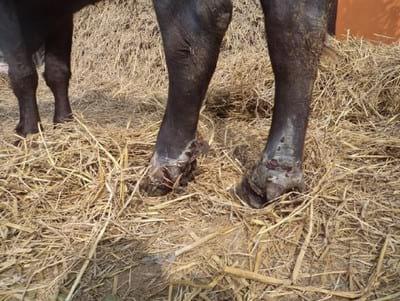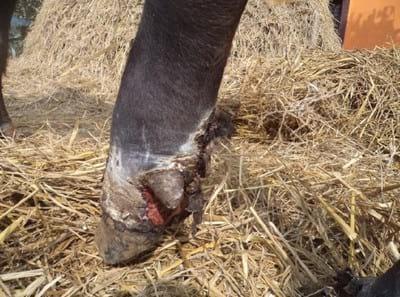Degnala disease
Why Degnala disease epidemic in buffaloes throughout South East Asia this year?
The harvesting of paddy was adversely affected in Nepal and other south Asian countries Due to long rain during the month of November and December. The rice plants were submerged in the paddy field and the rice straw got desiccated. Due to rain threat the farmers were compelled to store the rice straw without thorough drying.
As a consequence symptoms like drying and necrosis of tail and ear tip, swelling of legs and then drying, necrosis and gangrenous lesion on foot, reduction in milk production by 70-80% were observed in buffaloes fed to such straw. In Nepal such conditions were reported from districts like Jhapa, saptari, siraha, Rautahat, Chitwan, nawalparasi, Kathmandu, Nuwakot,Banke and Lamjung. The vet doctors and technicians working in such areas were treating such condition diagnosing as FMD, Black Quarter etc but without success.
In present context above mentioned disease is not only prevalent in vicinity of Deg River but also prevalent in all those areas where buffaloes are kept fed with rice straw. In India this disease is seen annually in Panjab, Hariyana, Uttar Pradesh, Uttaranchal, Bihar, Bengal, Jharkhand, chhatisgard states.
Pathogenesis Factor
The cause of symptoms in this disease has been thoroughly studied by this columnist during his Master degree in veterinary medicine. The mycotoxin produced by the metabolism of Fusariam fungus dissolves the collagen and elastin into collagenase and elastinase respectively. As a result in the dependent parts of ear, tail, foot blood supply is obstructed and ultimately tissue die of anoxia. In addition to this toxin severely affects liver, lungs, heart, and kidney.



- If possible avoid feeding of desiccated straw
- Feed properly dried straw and feed half quantity. Give adequate supplementation of green fodder and tree fodder.
- Treat the infected with sodium hydroxide @ 1% for 20kg straw.
- If available use pentasulphate @ 60 gm on first day and then @30 gm for next 15 days.
- Antidegnala liquid @ 10ml orally for 10 days.
- Mineral mixture and lactoline should be given along with straw.
- ARORA, S. P. (1980): Use of radioactive selenium for studies on Degnala disease. J. Nuclear Agri. Biol. 9, 11-13.
- BLOOD, D. C., O. M. RADOSTITS (1989): Veterinary Medicine, 7th ed. Bailliere Tindall. London.
- IRFAN, M. (1971): The clinical picture and pathology of Degnala disease in buffaloes. Vet. Rec. 88, 422-424.
- IRFAN, M., A. MAQBOOL (1986): Studies on Degnala disease in cattle and buffaloes. Pak. Vet. J. 6, 87-93.
- IRFAN, M., A. MAQBOOL, M. ASHFAQUE (1984): Importance of moulds, fungi and mycotoxins in food and feeds. Pak. Vet. J. 4, 187-192.
- KALRA, D. S., K. C. BHATIA, O. P. GAUTAM, M. V. S. CHAUHAN (1972): An obscure disease (possibly Deg Nala disease) in buffaloes and cattle. Studies on its epizootiolgy, pathology and etiology. Haryana Agri. Univ. J. Res. 2, 256-264.
- KHAJARERN, J., S. KHAJARERN, C. RATANASETHAKUL (1990): Efficacy of hydrated sodium calcium aluminosalicilate (Novasil) on the bioavailibility of aflatoxins in the ducks. Proc. 7th Fed. Asian Vet. Assoc. Congress. Pattaya, Thialand.
- PATTERSON, D. S. P., B. A. ROBERTS (1977): Mycotoxins in food and feed. Proceedings of second meeting on mycotoxins in animal disease. Aberdeen 1976 MAFF Pinner. p. 40.
- SCHOENTAL, R. (1980): Save your animals from Deg Nala disease. J. Nuclear Agri. Biol. 92, 27-28.
- SHIRLAW, J. E. (1939): Deg Nala disease of buffaloes. An account of the lesions and essential pathology. Indian Vet. Sci. Anim. Husb. 9, 853-864.
I live and do veterinary practice and dairy consultancy in the degnala disease District Shekhupura, Pakistan. DEGNAL is a drain for water supply to the surronding area this area is richly peddy growing area. Peddy is winter season crop when high moisture is present giving excellent environment for fusarium growth this provide fodder to the buffaloes. Buffaloes are more prone to this disease. Petasulphate mixture is the drug of choice for this problem.
Nepal Agricultural Research Council (NARC) has carried out an extensive research on Khari diseases as referred to by Dr Bist in the western districts of Baitadi, and Drachula. In the early 2012, NARC has already handed over a complete package of practice to the Department of Livestock Services (DLS), Government of Nepal for preventing, control and treatment of the Khari Disease syndrome. Yes, it is a complex disease syndrome. So Khari is no more a mysterious disease as it used to be 20 years ago. It is a syndrome (rather than a disease) and the treatment has been effectively used at the field level in Baitadi and Drachula districts.
There are many query Dr.Bista khari in darchula baitadi till date finding indicate that it is choronic selenosis with combine mycotoxicosis. Furthermore it is what I call Nepales vet disease syndrome. No it does not restrict to buffaloes only. Although the name of diseaes is Degnala. I have mentioned about its history. Now I will say it is moldy straw, feed, fodder poisoning in livestock pig, poulty, sheep, goat too, and equine is more venerable, so far there are documentation about it like in cattle it causes Endemic Moist Examatous syndrome, goat Dhakeri Bange Syndrome. In finisher broiler Sudden Death Syndrome. In Early chicks Spiking mortality Syndrom. In Sheep Facial eczema,in equine spp Equine Lucko Encephalomalacia. In pig HBS.










.jpg&w=3840&q=75)